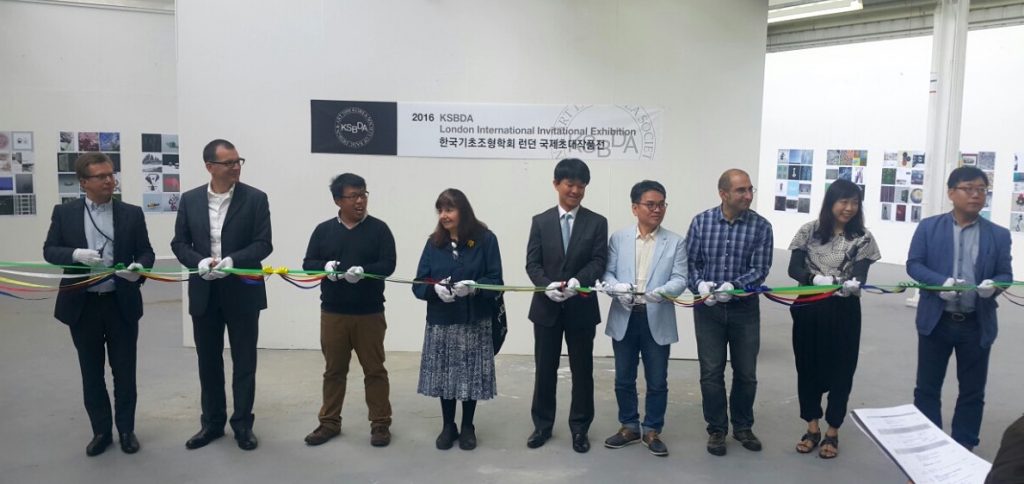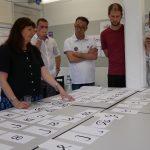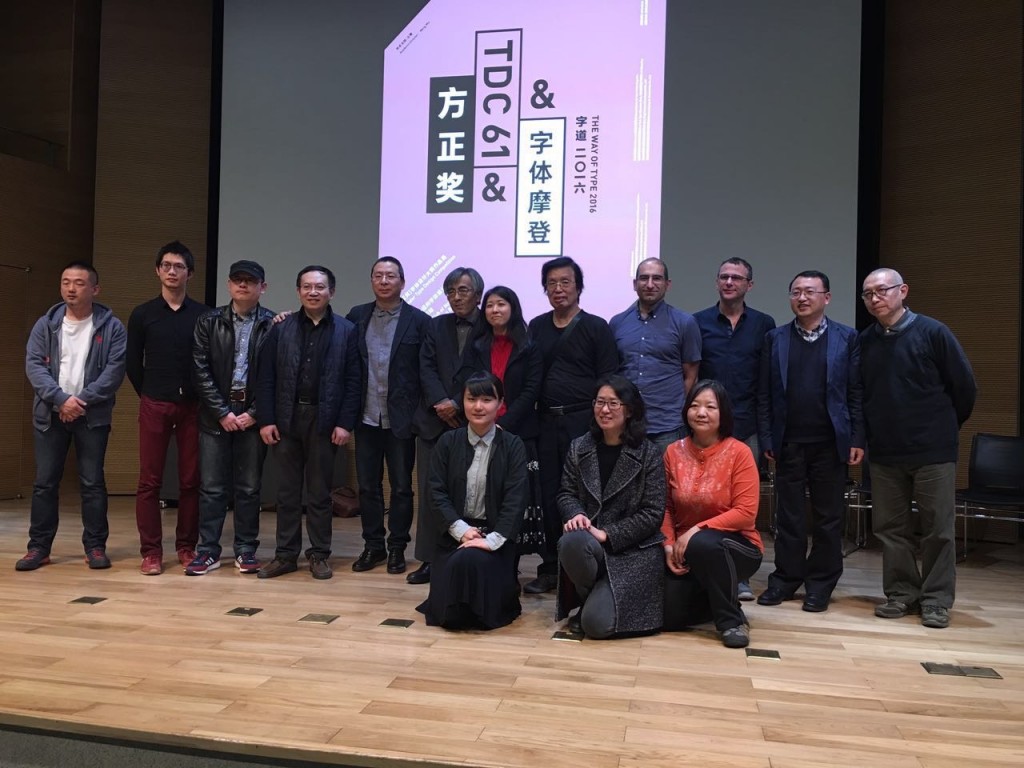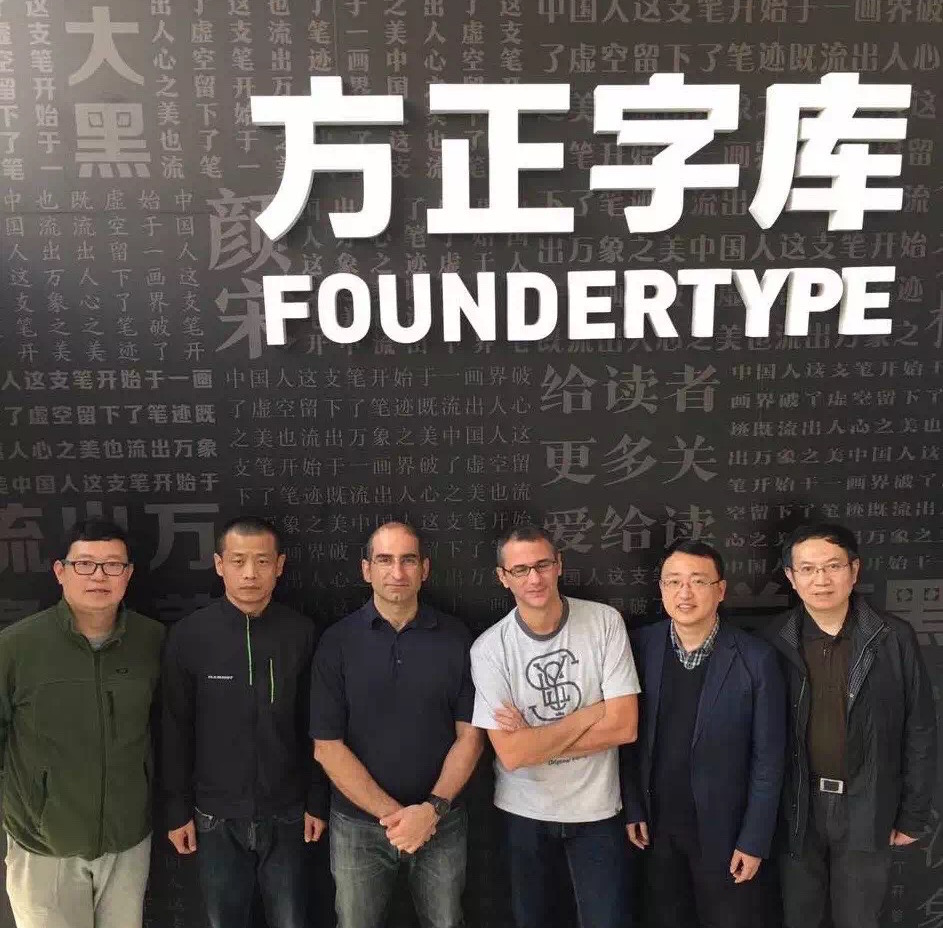‘Women in type: a social history of women’s role in type-drawing offices, 1910–90’ is a new three-year research project now underway in the Department, funded by the Leverhulme Trust and led by Professor Fiona Ross. The project team includes Dr Alice Savoie and Dr Helena Lekka. For more information about this exciting and timely project, see the Leverhulme Trust’s newsletter for January 2018 (p. 11).
Category Archives: staff
Irmi Wachendorff awarded competitive research studentship

Visiting lecturer Irmi Wachendorff
Congratulations to Visiting Lecturer, Irmi Wachendorff who has been awarded a studentship from the German Academic Scholarship Foundation. Irmi’s doctoral research at the University of Duisburg-Essen explores social positioning through typographic variation in linguistic landscapes.
Irmi has joined the Department for the spring term as a visiting lecturer from Folkwang University of Arts. Drawing on her extensive professional experience working in Germany, Switzerland and Australia, she is primarily working with our Part 2 students on practical projects while she is in Reading. She is also leading a new theme in the Design Thinking module: “Graphic design theory: Reflecting practice”.
Staff exchanges play a key role in knowledge exchange and we are pleased to have Irmi with us to share her cross-disciplinary expertise and professional experience. Welcome to the Deparment, Irmi, and congratulations on your achievement!
Material histories: Centennial Exhibition stencil
In the last in a series of posts about artefacts in the exhibition ‘Material histories’ (now on in the Department), Eric Kindel tells the story of a stencil cut to commemorate the 1876 Centennial Exhibition in Philadelphia.
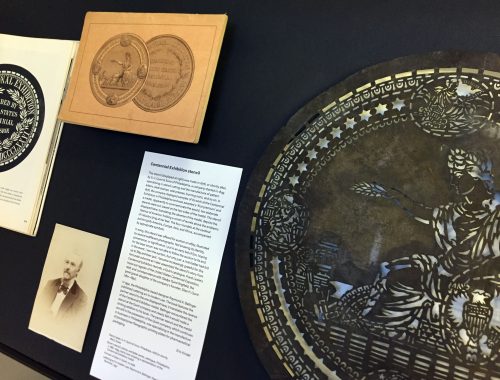
Centennial Exhibition stencil (at right), alongside (from left) Lettering art in modern use (1952) by Raymond A. Ballinger; portrait of Silas H. Quint (no date); and back cover of the catalogue Quint’s stencil, stamp, and letter works (c. 1887–1895) showing a representation of the Centennial Exhibition medal.
Centennial Exhibition stencil
This stencil (shown above, at right) was made in 1876, or shortly after, by S. H. Quint & Sons of Philadelphia, a company started in 1849 specialising in stencil cutting and the manufacture of pattern letters, steel stamps, seal presses, burning irons, and so on. In 1876, the company displayed samples of its work at the Centennial Exhibition in Philadelphia and was awarded a ‘first premium’ and a medal. Apparently to commemorate the award, two elaborate stencils were cut, based on the two sides of the medal. The stencil displayed here, translating the obverse of the medal, depicts the ‘Genius of America’ holding a crown of laurels above the emblems of industry lying at her feet. The four roundels at the cardinal points typify America, Europe, Asia, and Africa, accompanied by appropriate symbols.
In 2005, this stencil was offered for auction on eBay, illustrated by several indifferent photographs. Not knowing its identity, provenance, or significance, I put in an early bid of $70, hoping for the best since I was not able to follow the auction to its end. In the event, I won the auction, but only just: a rival bidder had bid up to $69 and then quit. I became increasingly grateful for this fortunate outcome as I later assembled the stencil’s story from Centennial Exhibition records, a Quint catalogue, Frank Leslie’s historical register of the United States Centennial Exposition, 1876, and correspondence with Gladys Quint Wigfield, the great grand-daughter of the company’s founder, Silas H. Quint (1821–1897).
In 1952, the Philadelphia-based designer Raymond A. Ballinger published Lettering art in modern use. The book features the partner stencil to the one displayed here; it translates the reverse of the Centennial Exhibition medal. Ballinger encountered the stencil at the Quint company and clearly felt it would make a striking addition to his book. The partner stencil and the medal are still in the possession of the Quint company, which continues in business in Philadelphia, now specialising in the manufacture of photopolymer flexographic printing plates for pharmaceutical packaging.
On display
Stencil plate, S. H. Quint & Sons, Philadelpia, 1876 (or shortly
after), brass
Quint’s stencil, stamp, and letter works, catalogue, Philadelphia,
c. 1887–1895, back cover showing a representation of the
Centennial Exhibition medal
Portrait of Silas H. Quint, no date
Lettering art in modern use, Raymond A. Ballinger, New York:
Reinhold, 1952
‘Material histories’ presents graphic communication artefacts with a story to tell. The stories – the material histories – describe the artefacts in particular: what they are about, where they came from, their material qualities, their circumstances of production, how they were acquired, and crucially how they link to other artefacts, narratives and representations.
The exhibition continues until 11 November.
Material histories: Tschichold & ampersands
In the third in a series of posts about artefacts in the exhibition ‘Material histories’ (now on in the Department), Rob Banham tells the story of Jan Tschichold’s history of the ampersand.

Formenwandlungen der et-zeichen (Forms of the ampersand) (1953) by Jan Tschichold (at upper right); letter from Georges Sarasin to Tschichold (centre); reprint of Formenwandlungen der et-zeichen (2004).
Jan Tschichold and the ampersand
This 28-page booklet (above, displayed open at upper right) is about the history of the ampersand. Published in 1953, it contains a short text by Jan Tschichold and 288 examples of different forms of the ampersand character. The examples range in date from 346 BC to the end of the nineteenth century. This particular copy, purchased on eBay in about 2004, came with a folded letter inside, dated 20 November 1954, written by Georges Sarasin to Tschichold. When I bought the booklet, the eBay listing mentioned the letter but not that the booklet had been inscribed to Sarasin by Tschichold. Nor did it say that on page 16 several errors in the caption numbering had been carefully corrected in pencil, presumably by Tschichold himself.
In the letter, Sarasin thanks Tschichold for sending him the booklet, and remarks on the amount of material collected and the effort this must have involved. He goes on to say, ‘It seems to me that such a publication is of particular importance, apart from the aesthetic pleasure, because it makes it quite obvious what we would lose if we banished capital letters when such a disposable character [i.e. the ampersand] has inspired such artistic achievements.’ Sarasin’s reference is to a debate that had begun in the 1920s when modernist typographers first proposed abolishing capital (or uppercase) letters in favour of only lowercase. This was something Tschichold had supported at the time: in 1930 he put forward ideas for a new script based on existing lowercase forms, and for a new orthography. But he later rejected the proposal to abolish capitals as unworkable.
Also on display are two earlier articles on the ampersand by Frederick W. Goudy and Paul Standard. Tschichold acknowledges both as the source of many of his examples: numerous entries in his list are followed by a ‘G’ for Goudy or an ‘S’ for Standard; those with a ‘T’ are items he sourced himself. Goudy’s article also appears to have provided a model for Tschichold, who reproduced his ampersands at the same size.
While Tschichold’s booklet is an example of his longstanding interest in the history of letterforms, it also demonstrates his mastery of understated typography, and the nuanced use of paper and binding in book design. The Japanese reprint, issued in 2004, is a pale imitation.
On display
Jan Tschichold, Formenwandlungen der et-zeichen (Forms of the ampersand), Frankfurt: Stempel, 1953
Copy of a letter sent by Georges S. Sarasin to Jan Tschichold, dated 20 November 1954
Formenwandlungen der et-zeichen, reprint with Japanese text, issued to accompany a Tschichold special issue of Idea magazine, 2004
Frederick William Goudy, ‘Ands & ampersands’, Typography, no. 3, 1937, pp. 11–18
Paul Standard, ‘The ampersand – sign of continuity’, Signature, no. 8, 1938, pp. 44–51
‘Material histories’ presents graphic communication artefacts with a story to tell. The stories – the material histories – describe the artefacts in particular: what they are about, where they came from, their material qualities, their circumstances of production, how they were acquired, and crucially how they link to other artefacts, narratives and representations.
The exhibition continues until 11 November.
Material histories: crossed letters
In the second in a series of posts about artefacts in the exhibition ‘Material histories’ (now on in the Department), Sue Walker tells the story of ‘crossed letters’.
Crossed letters
‘Crossing’ a letter was a widely-adopted letter-writing practice. The aim was to save paper and postal charges when – before the introduction of the Penny Post in 1840 – the cost of sending a letter was determined by the number of pages it contained and the distance it was sent. After 1840, letters with more than one sheet of paper could be sent cheaply throughout Britain. By the end of the nineteenth century letter-writing manuals and etiquette books cautioned against crossing, as the following quotations confirm:
‘Another practice of the past, now happily discontinued, was that of crossing letters; and two sheets of paper are used if one sheet will not contain all that is to be said. If half the second sheet of paper is left blank it is not torn off, a whole sheet being more convenient to hold and to fold than is half a sheet of paper, and if the last few words are necessary for the completion of a letter they are written on the margin and not across the writing on the face of the pages.’ (The correct guide to letter writing, by a member of the aristocracy, 1892)
‘Another almost entirely feminine fault is that of ‘crossing’ a letter. As one of the first requisites of a letter is that it should be distinctly written there cannot possibly be any valid excuse for “crossing”.’ (E. M. Busbridge, Letter writing and etiquette, 1909)
Some examples of crossing suggest that people did so to avoid starting a second sheet of paper, as they contain just a few lines written at 90 degrees to the rest. Crossing is also found in letters of a personal or intimate nature, as indicated by salutations such as ‘My own true Ernest’, ‘My dearest Ernest’ and ‘My very dear Ernest’ (see row of three letters, at lower right). Both sides of a sheet fully crossed suggest that in certain instances crossing was a deliberate ploy to disguise the messages within. Some crossed letters, especially those with generous space between the lines, are relatively easy to read. Others are more challenging, though one can imagine the unfolding delight of the recipient as they slowly deciphered a densely crossed text.
The crossed letters shown here are from a collection of family letters given to me by Vivian Wright, a librarian and friend of the Department. The collection is remarkable in its breadth, containing letters sent and received by children in the late nineteenth century, love letters, letters sent and received during the First World War, and day-to-day correspondence from the late nineteenth century to the 1960s.
On display
Crossed letters, 1880s–1910s
Etiquette books: The correct guide to letter writing, by a member of the aristocracy (published in many editions, usually undated; on display are editions from 1892 and the early 20th century); E. M. Busbridge, Letter writing and etiquette, 1909
‘Material histories’ presents graphic communication artefacts with a story to tell. The stories – the material histories – describe the artefacts in particular: what they are about, where they came from, their material qualities, their circumstances of production, how they were acquired, and crucially how they link to other artefacts, narratives and representations.
The exhibition continues until 11 November.
Material histories: Emil Hübner
‘Material histories’ is a small exhibition now on display in the Department. It presents graphic communication artefacts with a story to tell. The stories – the material histories – describe the artefacts in particular: what they are about, where they came from, their material qualities, their circumstances of production, how they were acquired, and crucially how they link to other artefacts, narratives and representations.
In the first in a series of posts about artefacts in the exhibition, James Mosley tells the story of Emil Hübner’s Exempla scripturae epigraphicae Latinae.
Exempla scripturae epigraphicae Latinae
Emil Hübner’s collection of Latin inscriptions, Exempla scripturae epigraphicae Latinae, is a big book. It is not easy for the ordinary reader to approach. All the text – and there is a lot of it – is in Latin. But every inscription that is listed is shown in a line illustration. Many of the original inscriptions are routine jobs, while others delightfully capture calligraphic qualities. The inscriptions, as presented in the book, are well drawn, often (according to the captions) from photographs of the originals. They are printed from ‘zincographs’, which are relief etchings made directly from the drawings. Zincography was a relatively new process at the time, whose early history needs recording.

Emil Hübner, Exempla scripturae epigraphicae Latinae, opened to item 265, a sample of letters from the inscription at the base of Trajan’s column, Rome.
Edward Johnston was rightly impressed with what he called these ‘fine outline drawings’, and he included samples of them in his little handbook, Writing & illuminating, & lettering (1906). In her book, Lettering on buildings (1960), Nicolete Gray complained that the scale of the originals was difficult to judge, which is true. But over a thousand inscriptions are shown and the size of each line is given.
So Hübner’s book is on many people’s list of things to look at. In 1979, I received a prospectus from a publisher in Berlin offering a reprint, which I ordered for the St Bride Library. What I got was a surprise: a copy of the original book, printed in 1885, and not bound, but sewn and ready to use. I imagine that before the reprint was put in hand someone must have come across copies of the original book that had somehow survived in a warehouse, perhaps in Berlin, for nearly a century. I tipped off the ‘Typography Department’ at Reading, which ordered its own copy of the 1885 printing. This is the copy displayed here.
At Reading, Hübner’s book served a serious purpose. Study tours of Rome and Florence to see inscriptions on the spot and in context had become a distinctive part of the teaching undertaken by the newly created department. My own contribution was to offer images of some of the originals that I had made during my own research trips, and which I used in my teaching. Two of these are on display.
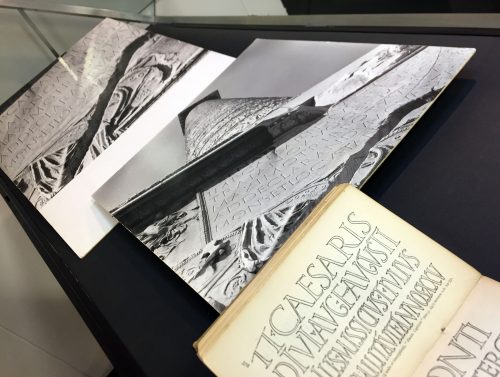
Edward Johnston, Writing & illuminating, & lettering, showing reproductions from Hübner; photographs of the inscription at the base of Trajan’s column, made by James Mosley in 1963.
On display
Emil Hübner, Exempla scripturae epigraphicae Latinae, Berlin: George Reimer, 1885
Edward Johnston, Writing & illuminating, & lettering, London: John Hogg, 1906 (2nd edition, 1908)
Inscription at the base of Trajan’s column, Rome, photographs by James Mosley, 1963
‘Material histories’ continues until 11 November.
Minister for disabled people visits Reading
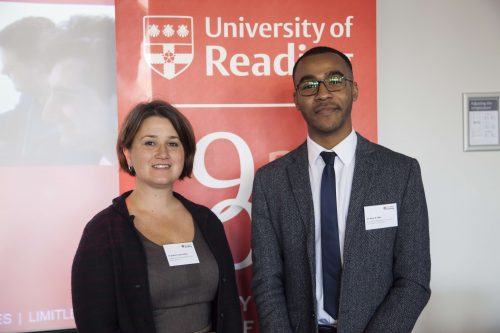
Dr Jeanne-Louise Moys with graduate Ryzard Akita following their presentations to the Minister
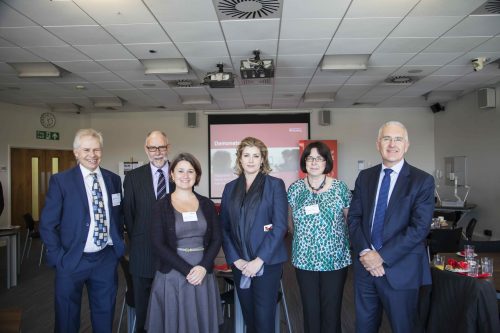
Penny Mordaunt, MP visited the University to meet our Breaking down Barriers team.
Yesterday, Penny Mordaunt, Minister for Disabled People, Health and Work visited the University of Reading to find out more about our transformative Breaking down Barriers (BdB) project.
BdB focuses on embedding inclusive design in our curricula across the University. Typography have been highly involved in the project from its inception and were proud to present the ways in which we are engaging with inclusive design across a range of applications including digital, print and wayfinding design.
In particular, we were pleased to welcome Ryzard Akita, one of our 2016 graduates who is now working as a user experience designer, back to Reading. Ryzard presented his final year self-directed project – an innovative mobile app for visually-impaired users – to the Minister. Some of our recent MA and undergraduate dissertations on inclusive design were also on display for the event.
The Minister also engaged with some of the simulation tools we have been using in our courses to increase students’ awareness of the everyday challenges people face in terms of mobility, dexterity and visibility. She praised the project, saying: “Inclusivity and accessibility should be at the forefront of good design, and I’m delighted to see the University of Reading leading the way with their Breaking down Barriers scheme.”
Rick Poynor joins Typography

We are very pleased to announce that Rick Poynor has been appointed Professor of Design and Visual Culture by the University of Reading, and will join the Department of Typography & Graphic Communication on 10 October.
As author, editor, curator and commentator, Rick’s longstanding and wide-ranging critical engagement with design, design history and many dimensions of visual culture is well known. We look forward with great anticipation to his contributions to Reading’s own longstanding excellence in teaching and research.
Welcome, Rick!
A July like any other in Reading
The Department of Typography did not get the memo that July is supposed to be a quiet period. We kicked off the month by hosting the KSBDA International Invitational Exhibition, its first stop after Seoul, and on its way to Katowice, Poland. The exhibition, attended by members of the current Board of the KSBDA and several past presidents, was held with the kind collaboration of the Department of Art. The visitors had the opportunity to examine material from the Collections in Typography, and discuss their use in teaching.
The second week of July saw many staff, research students, and postgraduates fly off to Thessaloniki, to take part in the 6th ICTVC conference. The triennial event is spearheaded by alumnus Dr Klimis Mastoridis and aligns closely to the research strands of the Department. Several members delivered papers, and Emeritus Professor Michael Twyman delivered the opening keynote.

Celebrating the Monotype Studentship, from left: senior designer Malou Verlomme, Type Director Dr Nadine Chahine, the VC Sir David Bell, and Head of Department Professor Eric Kindel.
Back in Reading, we marked the tenth anniversary of the Monotype Studentship, a substantial initiative in funding support for our postgraduates. The Studentship is only one element of our deep collaboration with the company, which stretches from research support to technical training.
- Gerry Leonidas describing the transition from manuscripts to print
- Fiona Ross leading a letterform identification exercise
- Gerard Unger on the typeface Swift
Over the two last weeks of July the Department was taken over by the annual TDi summer course. The international cohort (with participants from Bangladesh, Brazil, Canada, Dubai, India, Jordan, Korea, Malaysia, UAE, USA, as well as European countries and the UK) spent long days in sessions led by several members of the Department’s staff and student community, working in our studios, with material from the Department Collections, and personal staff collections. Through lectures and seminars, to hands-on sessions with archival material and letterpress equipment, the TDi provides a unique distillation of key areas of the Department’s narrative on typography and typeface design. Marek Jeziorek documented this year’s course in several albums, starting here.
Typography in Beijing
Soon after the conclusion of a successful visit by students from CAFA to Typography in 2015, we commenced working on a reciprocal visit to Beijing. As it happened, several strands of activity came together to make this an exceptionally productive visit. A short report follows below; the local organisers, led by CAFA teacher Liu Zhao, recorded all presentations for translation and reposting on the Chinese social networks, and microblogged almost every minute of the trip to a jaw-droppingly numerous online audience.
Opening the visit with a more formal occasion, Gerry Leonidas and José Scaglione (Reading alumnus and ATypI president) took part in the judging of the 8th Founder Type Design Competition. The event, held every two years, included for the first time Latin typefaces by Chinese designers. The next day, the winners were announced in the National Centre of the Performing Arts (the “Egg”), together with the opening of the TDC61 exhibition, the Chinese leg of the global tour of the annual design competition; and the opening of the “Chinese Type Modern 1919–1955” exhibition with material from the archives of Founder Electronics on the transition of Chinese type-making across technologies – with clear influence by Reading’s TDi 2015 course, in which Founder staff participated in.
Font Forum conference
The exhibition and competition awards served as the opening events for the two-day Font Forum, a conference on typeface design with speakers from China, Japan, and Europe, to packed auditoria. At the end of each day lively panel discussions demonstrated the interest of the student and professional audience, and the desire for stronger engagement with the international typographic community. (In the sidelines of the conference, plans were hatched to coordinate a BA module on typeface design between Reading and CAFA in 2016–17.)
CAFA workshop
The main part of the visit was taken over by a workshop on typeface design at CAFA. The interest in Latin typeface design is considerable, and the skills of many students impressive. This is a sign of the gradual globalisation of Chinese design education, and the demands by the local professional employers for skills that can serve markets across language and script regions. Although the workshop was primarily focused on typeface design, there was great interest in typographic design, and especially for mobile platforms.
Centre for Chinese Font Design and Research
Two visits at the Centre for Chinese Font Design and Research, hosted in the offices of Founder Electronics, focused on design issues in fonts for Chinese, design tools and processes, and professional training for multi-script design. The second of the visits had very concrete aims, with Gerry orchestrating the localisation of Glyphs (the key font design application) into Simplified Chinese, to enable designers in China to experiment with new workflows.
CITIC publisher agreement
Starting in TDi 2015, Gerry Leonidas guided Liu Zhao to compile a list of books on typography and typeface design in English to be translated into Chinese by CITIC, one of the most prominent publishers in the country. The project is progressing well with many rights already secured, and schedules for the translations and launches in place. Gerry’s involvement in the curation of the series provides the opportunity for the University’s approach to typographic scholarship to be transplanted in a new market in a unique manner. This is part of a wider collaboration between the University, CITIC, and CAFA, with the aim of building up typeface design education in China.
Dongdao Design
Despite the timing on a Sunday evening, over 140 designers from Dongdao, one of the largest design agencies in China, turned up to listen to José and Gerry talk about typeface design solutions and studies. The presentations were followed by Q&A sessions and interviews, which will be posted on Chinese social media with subtitles.
p.s. ATypI in Beijing?
Seeing in person the typographically maturing environment in Beijing and particularly the concretely supportive attitude in CAFA convinced José and Gerry (president and vice-president of ATypI respectively) of the importance and timeliness of bringing the annual conference of the type design community to mainland China. They outlined the key parameters of a proposal with Dean Wang Min and Liu Zhao, and explored timing options. Look for announcements through ATypI!





